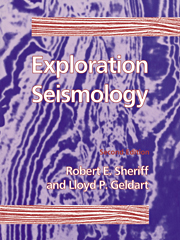Book contents
- Frontmatter
- Contents
- Preface
- Mathematical conventions and symbols
- 1 Introduction
- 2 Theory of seismic waves
- 3 Partitioning at an interface
- 4 Geometry of seismic waves
- 5 Seismic velocity
- 6 Characteristics of seismic events
- 7 Equipment
- 8 Reflection field methods
- 9 Data Processing
- 10 Geologic interpretation of reflection data
- 11 Refraction methods
- 12 3-D Methods
- 13 Specialized techniques
- 14 Specialized applications
- 15 Background mathematics
- Appendices
- Index
1 - Introduction
Published online by Cambridge University Press: 05 June 2012
- Frontmatter
- Contents
- Preface
- Mathematical conventions and symbols
- 1 Introduction
- 2 Theory of seismic waves
- 3 Partitioning at an interface
- 4 Geometry of seismic waves
- 5 Seismic velocity
- 6 Characteristics of seismic events
- 7 Equipment
- 8 Reflection field methods
- 9 Data Processing
- 10 Geologic interpretation of reflection data
- 11 Refraction methods
- 12 3-D Methods
- 13 Specialized techniques
- 14 Specialized applications
- 15 Background mathematics
- Appendices
- Index
Summary
Overview
Exploration seismology deals with the use of artificially generated elastic waves to locate mineral deposits (including hydrocarbons, ores, water, geothermal reservoirs, etc.), archaeological sites, and to obtain geological information for engineering. Exploration seismology provides data that, when used in conjunction with other geophysical, borehole, and geological data and with concepts of physics and geology, can provide information about the structure and distribution of rock types. Usually, seismic exploration is part of a commercial venture and, hence, economics is an ever-present concern. Seismic methods alone cannot determine many of the features that make for a profitable venture and, even when supplemented by other data, a unique interpretation is rarely evident. Seismic exploration usually stops long before unambiguous answers are obtained and before all has been learned that might possibly be learned, because in someone's judgment further information is better obtained in some other way, such as by drilling a well. Seismic methods are in continual economic competition with other methods.
Almost all oil companies rely on seismic interpretation for selecting the sites for exploratory oil wells. Despite the indirectness of the method–most seismic work results in the mapping of geological structure rather than finding petroleum directly–the likelihood of a successful venture is improved more than enough to pay for the seismic work. The enormous detail produced by 3-D techniques has opened up a huge reservoir engineering potential.
- Type
- Chapter
- Information
- Exploration Seismology , pp. 1 - 32Publisher: Cambridge University PressPrint publication year: 1995
- 2
- Cited by



